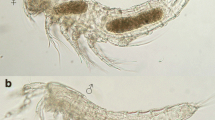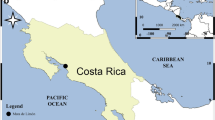Abstract
A detailed reexamination of male and female Entophilus mirabiledictu Markham & Dworschak, 2005 (an endoparasite of callianassid shrimp), resulted in recognition of seven female and five male characters that separate the species from its sole congener, E. omnitectus Richardson, 1903 (an endoparasite of munidid squat lobsters). These characters show that the two species are so different as to warrant E. mirabiledictu being placed in its own genus within the Entophilidae. Additionally, a review of the morphological features of entophilid cryptoniscus larvae led to the finding that the number of flagellar segments on the second antenna offers morphological support for a recent molecular phylogeny of epicaridean taxa that rearranged the component families within the two recognised superfamilies. This work highlights the power of using larval characters in testing hypotheses on the evolutionary relationships of epicaridean taxa.



Similar content being viewed by others
References
Adkison, D. L. (1990). A review of the Entoniscinae (Isopoda: Epicaridea: Entoniscidae). Ph.D. Dissertation, Tulane University.
Adkison, D. L., & Collard, S. B. (1990). Description of the cryptoniscium larva of Entophilus omnitectus Richardson, 1903 (Crustacea: Isopoda: Epicaridea) and records from the Gulf of Mexico. Proceedings of the Biological Society of Washington, 103, 649–654.
Anderson, G., & Dale, W. E. (1981). Probopyrus pandalicola (Packard) (Isopoda, Epicaridea): morphology and development of larvae in culture. Crustaceana, 41, 143–161.
Bourdon, R. (1976). Épicarides de Madagascar. I. Bulletin du Muséum National d’Histoire Naturelle, 3e sér., 371, 353–392.
Boyko, C. B., & Williams, J. D. (2009). Crustacean parasites as phylogenetic indicators in decapod evolution. In: Martin, J. W., Crandall, K. A. & Felder, D. L. (Eds) Crustacean Issues 18. Decapod Crustacean Phylogenetics. Boca Raton, FL, USA: CRC Press, pp. 197–220.
Boyko, C. B., & Williams, J. D. (2011). Chapter 9. Parasites and other symbionts of squat lobsters. In: Poore, G. C. B., Ahyong, S. T. & Taylor, J. (Eds) The Biology of Squat Lobsters. Melbourne: CSIRO Publishing, pp. 271–295 (also issues as Crustacean Issues, Volume 20 by CRC Press: Boca Raton, FL, USA with same pagination),
Boyko, C. B., Williams, J. D., & Markham, J. C. (2012). Recent and fossil Isopoda Bopyridae parasitic on squat lobsters and porcelain crabs (Crustacea: Anomura: Chirostyloidea and Galatheoidea), with notes on nomenclature and biogeography. Zootaxa, 3150, 1–35.
Boyko, C. B., Moss, J., Williams, J. D., & Shields, J. D. (2013). A molecular phylogeny of Bopyroidea and Cryptoniscoidea (Crustacea: Isopoda). Systematics and Biodiversity, 11, 495–506.
Cericola, M. J., & Williams, J. D. (2015). Prevalence, reproduction and morphology of the parasitic isopod Athelges takanoshimensis Ishii, 1914 (Isopoda: Bopyridae) from Hong Kong hermit crabs. Marine Biology Research, 11, 236–252.
Dale, W. E., & Anderson, G. (1982). Comparison of morphologies of Probopyrus bithynis, P. floridensis, and P. pandalicola reared in culture (Isopoda, Epicaridea). Journal of Crustacean Biology, 2, 392–409.
Dworschak, P. C. (2003). A new species of ghost shrimp from the Gulf of Aquaba, Red Sea (Crustacea: Decapoda: Callianassidae). Annalen des Naturhistorischen Museums in Wien, 104B, 415–428.
Glenner, H., Høeg, J. T., Stenderup, J., & Rybakov, A. V. (2010). The monophyletic origin of a remarkable sexual system in akentrogonid rhizocephalan parasites: A molecular and larval structural study. Experimental Parasitology, 125, 3–12.
Macpherson, E. (1994). Crustacea Decapoda : Studies on the genus Munida Leach, 1820 (Galatheidae) in New Caledonian and adjacent waters with descriptions of 56 new species. In: Crosnier, A. (Ed.) Résultats des Campagnes MUSORSTOM 12. Mémoires du Muséum National d’Histoire Naturelle (A), 161, 421–569.
Markham, J. C. (1994). Crustacea Isopoda: Bopyridae in the MUSORSTOM collections from the tropical Indo-Pacific I. Subfamilies Pseudioninae (in part), Argiinae, Orbioninae, Athelginae and Entophilinae. In: Crosnier, A. (Ed.) Résultats des Campagnes MUSORSTOM 10(6). Mémoires du Muséum National d’Histoire Naturelle (A), 161, 225–253.
Markham, J. C., & Dworschak, P. C. (2005). A new species of Entophilus Richardson, 1903 (Isopoda: Bopyridae: Entophilidae) from the Gulf of Aqaba. Journal of Crustacean Biology, 25, 413–419.
Miyashita, Y. (1940). On an entoniscid with abbreviated development, Entoniscoides okadai, n. g., n. sp. Annotationes Zoologicae Japonenses, 19, 149–156.
Rybakov, A. V., Korn, O. M., Høeg, J. T., & Waloszek, D. (2002). Larval development in Peltogasterella studied by scanning electron microscopy (Crustacea: Cirripedia: Rhizocephala). Zoologischer Anzeiger, 241, 199–241.
Schultz, G. A. (1977). Bathypelagic isopod Crustacea from the Antarctic and southern seas. Biology of the Antarctic seas V. Antarctic Research Series, 23, 69–128.
Shiino, S. M. (1942). On the parasitic isopods of the family Entoniscidae, especially those found in the vicinity of Seto. Memoirs of the College of Science, Kyoto Imperial University. Ser. B, 17, 37–76.
Tattersall, W. M. (1911). Die nordischen Isopoden. Kiel & Leipzig: Lipsius & Tischer.
Williams, J. D., & An, J. (2009). The cryptogenic parasitic isopod Orthione griffenis Markham, 2004 from the eastern and western Pacific. Integrative and Comparative Biology, 49, 114–126.
Acknowledgements
Thanks to Peter Dworschak (NHMW) for loan of specimens.
Funding
The research was supported by a National Science Foundation Grant (DBI-1337525) awarded to J. D. Williams (Hofstra University).
Conflict of interest
The authors declare that they have no conflict of interest.
Compliance with ethical standards
All applicable institutional, national and international guidelines for the care and use of animals were followed.
Author information
Authors and Affiliations
Corresponding author
Rights and permissions
About this article
Cite this article
Boyko, C.B., Williams, J.D. A new genus for Entophilus mirabiledictu Markham & Dworschak, 2005 (Crustacea: Isopoda: Cryptoniscoidea: Entophilidae) with remarks on morphological support for epicaridean superfamilies based on larval characters. Syst Parasitol 92, 13–21 (2015). https://doi.org/10.1007/s11230-015-9578-8
Received:
Accepted:
Published:
Issue Date:
DOI: https://doi.org/10.1007/s11230-015-9578-8




